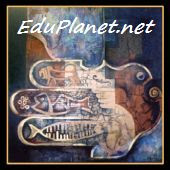Midrash
taken from http://www.wujs.org.il/activist/learning/guide/midrash.shtml
what is it?
Midrash is the name given to certain collections of writings that are ordered around the layout of the Tanach. The Midrash is distinguished by the high amount of Aggadah it contains. Aggadah is the name given to a certain kind of writing (be it history, story, legend, allegory, scientific observation or such like) that is not legal or concerned with law. The Midrash is, therefore, mostly collections of stories that relate to words, themes, or narratives in the Tanach.
The word Midrash comes form the Hebrew root 'darash', meaning to search or investigate. Midrash attempts, through minute examination and interpretation of the Tanach, to bring out the deeper or ethical meaning of the text.
There are many different collections of Midrash. The largest collection is called Midrash Rabbah (The Great Midrash), which consists of a number of volumes. Other collections include Pesikta (Divisions), Mechilta (Treatise), Sifra (Book), and Sifre (Books).
what is it about?
The Midrash is about a wide variety of topics. Faced with opposition from those who interpreted Torah in a strictly literal sense, the Rabbis sought to find more subtle meanings within the words of Torah. The Midrash often includes whole stories from an examination of a word or words. Other times, the Midrash will fill in an apparent gap in a story. The Midrash can be thought of as an attempt to discover the inner meaning of Tanach.
There are two main types of Midrash - Midrash Aggadah and Midrash Halachah. Midrash Aggadah is the most common and contains stories and legends, concerned with ethical teachings or other topical issues. Midrash Halachah expounds upon the legal aspects and implications of texts in Tanach. Midrash Halachah and Midrash Aggadah exist side by side in the same way that Halachic (to do with Jewish Law) and Aggadic (not to do with Jewish Law) material exist together in the Talmud. However some volumes contain mostly Midrash Halachah, and others mostly Midrash Aggadah.
Midrash Rabbah contains volumes on the Chumash (Five Books of Moses) and the Hamesh Megillot (Five Scrolls, from Ketuvim).
The Pesikta (Divisions) is really three different works, based around the Shabbat and festival readings from the Prophets (the Haftorot).
Mechilta (Tractate) is a Midrash to Shemot (Exodus). Sifra (Book) is a Midrash to Vayikra (Leviticus). Sifre (Books) is a Midrash to Bamidbar (Numbers) and Devarim (Deuteronomy). All three are mainly Halachic (to do with Jewish Law). Different Midrashim are sometimes repeated in different collections.
where does it come from? who wrote it down?
The Midrashim are thought by some to have been divinely inspired and so are part of the religious corpus. Some are meant to be interpreted literally and others aren't, but all are meant to be taken seriously.
The material of the Midrash is mostly from the time of the Amoraim (200 - 500 CE). Some of the Midrash (particularly Mechilta, Sifra, and Sifre) can be traced back to the Tannaim (400 BCE - 200 CE).
Different Midrashim were written down at different times, over a period of almost a thousand years, from 300 - 1200 CE.
The compilers of the different collections of Midrash are generally unknown.
what do we do with it?
Because of the accessibility of a story, and the ethical messages that they contain, Midrashim are often used in preaching. Rabbis' sermons often start with a Midrash, which is used to bring out the deeper meaning of a passage from Tanach.
Many of the stories that are taught about characters from the Tanach are from Midrash. Because the Midrash is written to fill in gaps in the narrative, any attempt to reconstruct the lives of characters from Tanach will necessarily include a use of the Midrash. The film, 'Prince of Egypt', for example, was full of material taken from collections of Midrash.
Midrash was translated into Modern Hebrew by early Zionists.Writers such as Bialik collected various stories from Midrash, and published them to encourage Jews to read from the actual body of Jewish tradition. Today Midrash is often studied as literature, as well as a religious text.
what language is it in?
The Midrash, like the Talmud, is written in a combination of Hebrew and Aramaic. Some parts are in Hebrew, most are in Aramaic, and others are a combination of the two.
what does it look like?
This page is from the 1923 Vilna Edition of the Midrash Rabbah. (1) is the Midrash. (2), (3), (4) and (7) are commentaries. (5) compares different versions of stories in different volumes of Midrash. (6) suggests emendations to the text. (8) is a collection of cross-references and sources.
if I want to read it...
There is a translation of the Midrash Rabbah published by Soncino. This comes in ten volumes, including an index. It is a well-written and fairly straightforward translation.
The Sefer HaAggadah (Book of Legends) by Bialik and Ravinitzky is a compilation of many stories from both Midrash and Talmud. It is very well written and contains a very wide range of material, with a clear indication of the source. It is an expensive book, but can frequently be found in Jewish libraries.

No comments:
Post a Comment